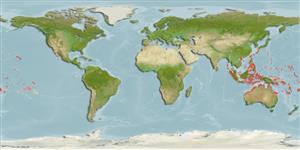>
Blenniiformes (Blennies) >
Blenniidae (Combtooth blennies) > Salariinae
Etymology: Entomacrodus: Greek, ento = inside + Greek, makros = big + Greek, odous = teeth (Ref. 45335); caudofasciatus: Name from Latin 'cauda' for tail and 'fasciatus' meaning with bars, referring to the caudal-fin color pattern of the species (R. Bajol, pers. Comm. 11/14).
More on author: Regan.
Environment: milieu / climate zone / depth range / distribution range
Ecología
marino asociado a arrecife; rango de profundidad 0 - 3 m (Ref. 30874). Tropical; 32°N - 31°S
Indo-Pacific: Andamans to Ducie Islands, north to southern Japan, south to Cocos-Keeling, Kermadec, and Rapa Islands; Belau and Marshall Islands in Micronesia.
Tamaño / Peso / Age
Maturity: Lm ? range ? - ? cm
Max length : 6.2 cm SL macho / no sexado; (Ref. 1602)
Short description
Claves de identificación | Morfología | Morfometría
Espinas dorsales (total) : 13; Radios blandos dorsales (total) : 14 - 16; Espinas anales: 2; Radios blandos anales: 15 - 17.
Facultative air-breathing (Ref. 126274); Adults are found along rocky intertidal shorelines, benches, outer reef flats, and reef margins subject to some degree of wave action. Feeds on filamentous algae (Ref. 89972). Oviparous. Eggs are demersal and adhesive (Ref. 205), and are attached to the substrate via a filamentous, adhesive pad or pedestal (Ref. 94114). Larvae are planktonic, often found in shallow, coastal waters (Ref. 94114).
Life cycle and mating behavior
Madurez | Reproducción | Puesta | Huevos | Fecundidad | Larva
Oviparous, distinct pairing (Ref. 205).
Myers, R.F., 1991. Micronesian reef fishes. Second Ed. Coral Graphics, Barrigada, Guam. 298 p. (Ref. 1602)
IUCN Red List Status (Ref. 130435: Version 2024-2)
Threat to humans
Harmless
Human uses
Herramientas
Special reports
Download XML
Fuentes de Internet
Estimates based on models
Preferred temperature (Ref.
123201): 24.7 - 29.3, mean 28.5 °C (based on 1763 cells).
Phylogenetic diversity index (Ref.
82804): PD
50 = 0.5000 [Uniqueness, from 0.5 = low to 2.0 = high].
Bayesian length-weight: a=0.00776 (0.00356 - 0.01695), b=3.00 (2.81 - 3.19), in cm total length, based on LWR estimates for this (Sub)family-body shape (Ref.
93245).
Nivel trófico (Ref.
69278): 2.0 ±0.00 se; based on food items.
Resiliencia (Ref.
120179): Alto, población duplicada en un tiempo mínimo inferior a 15 meses (Preliminary K or Fecundity.).
Fishing Vulnerability (Ref.
59153): Low vulnerability (10 of 100).
Nutrients (Ref.
124155): Calcium = 234 [108, 447] mg/100g; Iron = 1.01 [0.54, 1.87] mg/100g; Protein = 17.8 [16.5, 19.1] %; Omega3 = 0.0749 [, ] g/100g; Selenium = 16.5 [7.1, 41.0] μg/100g; VitaminA = 140 [33, 612] μg/100g; Zinc = 3.29 [2.05, 5.07] mg/100g (wet weight);
